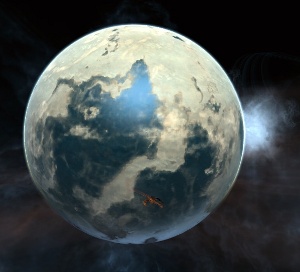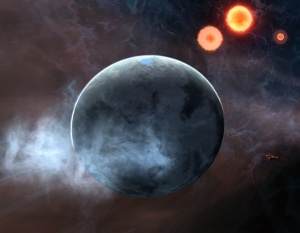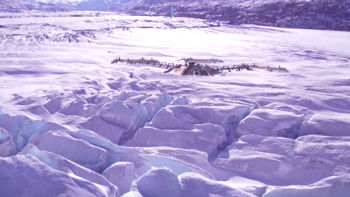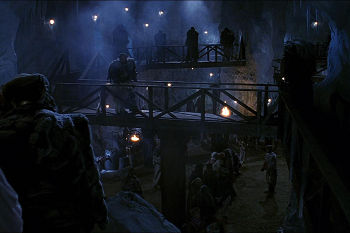Sector Quads
Quadrants were divided into numbered Subquadrants and Sector Zones. The intersection of a subquadrant and a sector zone resulted in a roughly cube-shaped Sector Grid, which was 5000 light years long and 3600 light years high along the galactic plane; the width varied by distance from the galactic core—at the rim, it could be as wide as 8727 light years. Each sector grid was then divided into a cubic grid of 100 Sector Quads, which were then further broken down into 900 ore more roughly cubical Sector Blocks, each measuring nearly 100 cubic light years (varying by distance from the galactic core). Finally, sector blocks were divided into 100 sectors, each measuring 20 cubic light years.Sector numbers were a nine-digit sequence with the first two digits representing the sector grid, the first digit of which represented the subquadrant and the second the sector zone (e.g. Sector Grid 15 was the intersection of subquadrant 1 and sector zone 5); the next two digits represented the sector quad; the next three digits represented the sector block; and the final two digits represented the sector proper. Prior to the mid-24th century, sector quads were commonly, though erroneously, referred to as “quadrants.” This practice fell into disuse, however, due to the widespread confusion it often generated.[1]
References
Sector Grids
Quadrants were divided into numbered Subquadrants and Sector Zones. The intersection of a subquadrant and a sector zone resulted in a roughly cube-shaped Sector Grid, which was 5000 light years long and 3600 light years high along the galactic plane; the width varied by distance from the galactic core—at the rim, it could be as wide as 8727 light years. Each sector grid was then divided into a cubic grid of 100 Sector Quads, which were then further broken down into 900 ore more roughly cubical Sector Blocks, each measuring nearly 100 cubic light years (varying by distance from the galactic core). Finally, sector blocks were divided into 100 sectors, each measuring 20 cubic light years. Sector numbers were a nine-digit sequence with the first two digits representing the sector grid, the first digit of which represented the subquadrant and the second the sector zone (e.g. Sector Grid 15 was the intersection of subquadrant 1 and sector zone 5); the next two digits represented the sector quad; the next three digits represented the sector block; and the final two digits represented the sector proper.[1]
References
Sector Blocks
Quadrants were divided into numbered Subquadrants and Sector Zones. The intersection of a subquadrant and a sector zone resulted in a roughly cube-shaped Sector Grid, which was 5000 light years long and 3600 light years high along the galactic plane; the width varied by distance from the galactic core—at the rim, it could be as wide as 8727 light years. Each sector grid was then divided into a cubic grid of 100 Sector Quads, which were then further broken down into 900 ore more roughly cubical Sector Blocks, each measuring nearly 100 cubic light years (varying by distance from the galactic core). Finally, sector blocks were divided into 100 sectors, each measuring 20 cubic light years. Sector numbers were a nine-digit sequence with the first two digits representing the sector grid, the first digit of which represented the subquadrant and the second the sector zone (e.g. Sector Grid 15 was the intersection of subquadrant 1 and sector zone 5); the next two digits represented the sector quad; the next three digits represented the sector block; and the final two digits represented the sector proper.[1]
References
Sectors
Quadrants were divided into numbered Subquadrants and Sector Zones. The intersection of a subquadrant and a sector zone resulted in a roughly cube-shaped Sector Grid, which was 5000 light years long and 3600 light years high along the galactic plane; the width varied by distance from the galactic core—at the rim, it could be as wide as 8727 light years. Each sector grid was then divided into a cubic grid of 100 Sector Quads, which were then further broken down into 900 ore more roughly cubical Sector Blocks, each measuring nearly 100 cubic light years (varying by distance from the galactic core). Finally, sector blocks were divided into 100 sectors, each measuring 20 cubic light years. Typically, a sector contained approximately 40 stars, about two-thirds of which were part of binary, trinary, or even quadrinary systems. However, in dense globular star clusters, a sector may have contained several thousand stars, and in the void between spiral arms, sectors may have contained no stars at all.[2]
› Continue reading
Saturn

Saturn (TNG-101-102)
Saturn was the sixth planet in the Sol System. The Talosians viewed an image of the Sol System while accessing the U.S.S. Enterprise NCC-1701‘s computer in 2254.[1]
References
San Francisco Fleet Yards
Shipbuilding facility orbiting the planet Earth, with offices on the surface in San Francisco, California. Several ships were built there, including:
- Enterprise NX-01[6]
- U.S.S. Enterprise NCC-1701[1]
- U.S.S. Enterprise NCC-1701-A[3]
- U.S.S. Enterprise NCC-1701-E[5]
- U.S.S. Excelsior NCC-2000[2]
- U.S.S. Sutherland NCC-72015[4]
References
- 1. “The Cage.” Star Trek, Episode 00. Television. 1965 (Unaired).
- 2. Star Trek III: The Search for Spock. Film. 1 June 1984.
- 3. Star Trek IV: The Voyage Home. Film. 26 November 1986.
- 3. “Redemption, Part II.” Star Trek: The Next Generation, Episode 201. Television. 23 September 1991.
- 5. Star Trek: First Contact. Film. 22 November 1996.
- 6. “Broken Bow.” Star Trek: Enterprise, Episodes 01-02. Television. 26 September 2001.
San Francisco

San Francisco (ST-06)

San Francisco (VOY-122)

San Francisco (ENT-01-02)

San Francisco (ENT-01-02)

Starfleet Communications (VOY-230)

San Francisco, 1893 (TNG-226)

San Francisco, 1893 (TNG-227)
Located in California on Earth. Many key Starfleet facilities were located within the city, including Starfleet Academy[3] and Starfleet Command,[2], as well as the offices of the San Francisco Fleet Yards.[1] Jonathan Archer was raised in San Francisco.[6]
Lieutenant Commander Data was transported from Devidia II in 2368 to San Francisco in 1893 while pursuing a group of Devidians who were traveling through time.[4] Cholera had broken out in the city at this time, and the Devidians were using it as to cover up the fact that they were harvesting Human neural energy as a food source. Guinan and Samuel “Mark Twain” Clemens lived in San Francisco in 1893, and they encountered Data and Jean-Luc Picard, who had followed Data back in time.[5]
References
Rura Penthe

Rura Penthe (STO)

Rura Penthe (STO)

Rura Penthe surface (ENT-45)

Rura Penthe prison (ST-06)
Frozen planetoid used by the Klingons as a high-security prison camp.[1] Rura Penthe was located in the Mempa Sector of the Beta Quadrant, approximately 11.5 light years from Qo’noS.[3] The prison was located underground as the surface weather was inhospitable and unable to support humanoid life. The conditions on Rura Penthe meant that being incarcerated there was as good as a death sentence, as many prisoners were forced to work under terrible conditions in the dilithium mines.[1] Captain Jonathan Archer was imprisoned a short time at Rura Penthe before being rescued by his crew in 2153.[2] Captain James T. Kirk and Dr. Leonard McCoy also served time on Rura Penthe, after being falsely accused of assassinating Chancellor Gorkon in 2291.[1]
ST11 Timeline
After traveling through time from 2387, the Romulan renegade Nero and his crew were captured in 2233 by the I.K.S. Klothos, under the command of Captain Kor and imprisoned at Rura Penthe,[5] where they remained in captivity until their escape in 2258.[4, 6]
References
- 1. Star Trek VI: The Undiscovered Country. Film. 6 December 1991.
- 2. “Judgment.” Star Trek: Enterprise, Episode 45. Television. 9 April 2003.
- 3. “Star Trek: Star Charts.” Star Trek (Uncategorized). Book. October 2002.
- 4. Star Trek. Film. 8 May 2009.
- 5. “Number One.” Star Trek: Nero, Issue 1. IDW Publishing. February 2010.
- 6. “Number Two.” Star Trek: Nero, Issue 2. IDW Publishing. March 2010.
Relay Station 194
Communications station used to amplify and retransmit subspace messages. RS194 was off-line for maintenance for several hours in early 2369, and RS47 accepted the additional comm traffic for that period.[1]
References
Relay Station 47
Relay Station 47 was a remote Starfleet communications station near the Klingon border in the late 24th century. Most of the operations of the station were automated, although a two-person crew provided for nonroutine operations and maintenance. A network of such stations throughout Federation space permitted interstellar communication between distant points with much shorter time lags than unboosted subspace radio transmissions would require. Lieutenant Aquiel Uhnari, assigned to RS47 in 2369, was under investigation for the murder of her crewmate, Lieutenant Keith Rocha, shortly after her assignment to the station, but she was soon exonerated.[1]
References
Categories
- Animated Series (60)
- Articles (28)
- Books (447)
- Cast & Crew (79)
- Comics (22)
- DS9 (328)
- Early Voyages (125)
- Education (5)
- Enterprise (373)
- Excelsior (36)
- Food (19)
- Games (223)
- Klingon (70)
- Library (1,543)
- Logs (593)
- Lost Era (55)
- Medicine (18)
- Merrimac (1)
- Mirror (35)
- Miscellaneous (13)
- New Frontier (54)
- Next Generation (635)
- Original Series (681)
- Personnel (436)
- Places (369)
- Politics (12)
- Recreation (10)
- SCE (41)
- Science (1)
- Shatnerverse (9)
- Ships (455)
- Site Updates (98)
- Starfleet Academy (86)
- Stargazer (42)
- STO (61)
- Technology (45)
- Titan (59)
- To Boldly Go (1)
- TV/Film (214)
- Uncategorized (4)
- Vanguard (76)
- Voyager (236)
- Weapons (27)
- Xenology (54)